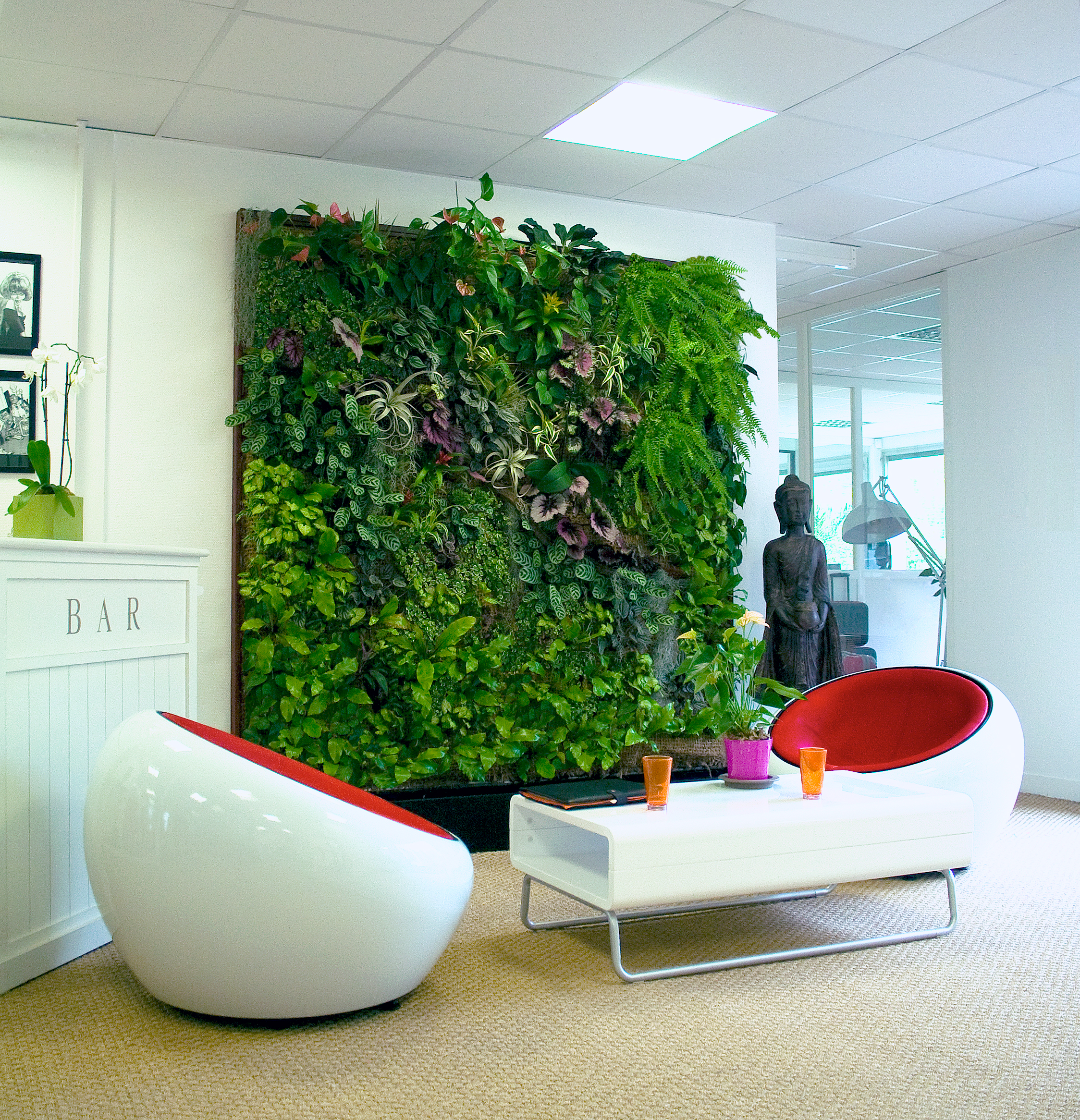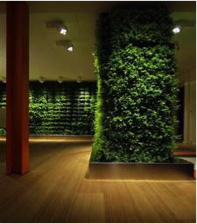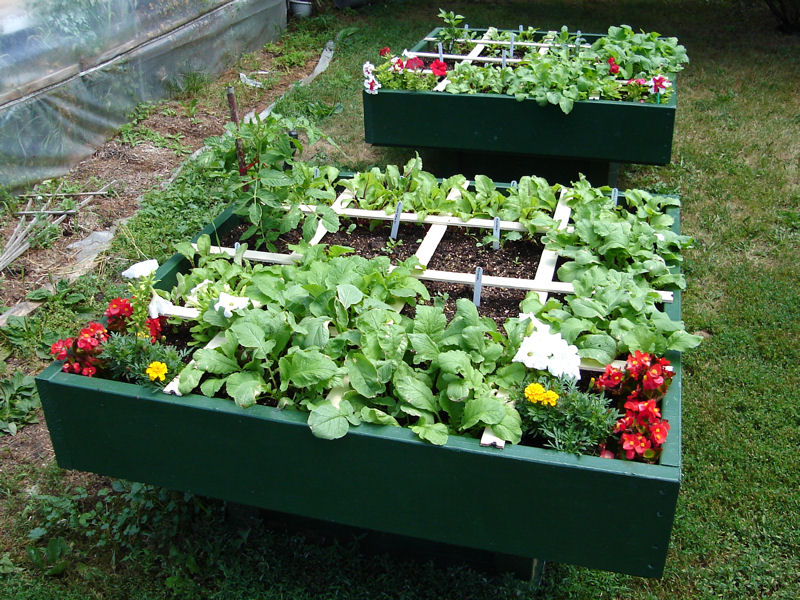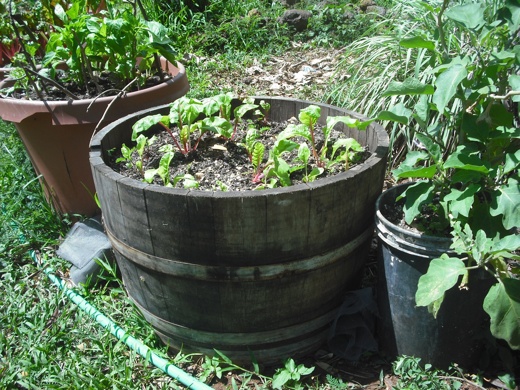Green Wall From Wikipedia, the free encyclopedia
 |
| An indoor green wall |
Such walls may be indoors or outside, freestanding or attached to an existing wall, and come in a great variety of sizes. As of 2012, the largest green wall covers 2,700 square meters (29,063 square feet or more than half an acre) and is located at the Los Cabos International Convention Center.
Green walls have seen a recent surge in popularity. Of the 61 large-scale outdoor green walls listed in an online database provided by greenroof.com, 80% were constructed in or after 2009 and 93% dated from no later than 2007. Many Iconic green walls have been constructed by Institutions and in public places such as Airports and are now becoming common, to improve the aesthetics. For example: Edmonton International Airport(Canada), Changi International Airport (Singapore) & Chhattrapati Shivaji International Airport (Mumbai, India).
While Patrick Blanc is sometimes credited as having developed the concept in the late 1980s, the actual inventor is Stanley Hart White, a Professor of Landscape Architecture who patented a green wall system in 1938.
Types
Green wall at the Universidad del Claustro de Sor Juana
in the historic center of Mexico City.
|
Loose Media
Loose medium walls tend to be "soil-on-a-shelf" or "soil-in-a-bag" type systems. Loose medium systems have their soil packed into a shelf or bag and are then installed onto the wall. These systems require their media to be replaced at least once a year on exteriors and approximately every two years on interiors. Loose soil systems are not well suited for areas with any seismic activity. Repairs can only be made by re-stuffing soil into the holes on the wall, which is both difficult and messy. Loose-soil systems should not be used in areas where there will be a lot of public interaction as they are quite messy and lose their soil little by little over time. Most importantly, because these systems can easily have their medium blown away by wind-driven rain or heavy winds, these should not be used in applications over 8 feet high. There are some systems in Asia that have solved the loose media erosion problem by use of shielding systems to hold the media within the green wall system even when soil liquefaction occurs under seismic load. In these systems, the plants can still up-root themselves in the liquified soil under seismic load, and therefore it is required that the plants be secured to the system to prevent them from falling from the wall. Loose-soil systems without physical media erosion systems are best suited for the home gardener where occasional replanting is desired from season to season or year to year. Loose-soil systems with physical media erosion systems are well suited for all green wall applications.
Mat Media
 |
| Mat media covered with layers of felt mats or coir fibre and then planted. |
Structural Media
 |
| Vertical Garden - Flowers & Vegetables |
There is some discussion also around "active" living walls. An active living wall actively pulls or forces air through the plants leaves, roots and growth medium of the wall and then into the building's HVAC system to be recirculated throughout the building. A problem with these systems is that building code still requires all the standard air filtration equipment that would have to be installed anyway, despite the living wall's installation. This means that active living walls do not improve air quality to the point that the installation of other air quality filtration systems can be removed to provide a cost-savings. Therefore, the added cost of design, planning and implementation of an active living wall is still in question. With further research and UL standards to support the air quality data from the living wall, building code may one day allow for our buildings to have their air filtered by plants.[citation needed]
The area of air quality and plants is continuing to be researched. The majority of the research cited is from NASA's studies performed in the 1970s and 1980s by B.C. Wolverton. There was also a study performed at the University of Guelph by Alan Darlington. Other research has shown the effect the plants have on the health of office workers."The Effect of Indoor Foliage Plants on Health and Discomfort Symptoms among Office Workers". Retrieved 2010-12-23..
Function
 |
| An indoor green wall in an office in Hong Kong. |
Living walls may also be a means for water reuse. The plants may purify slightly polluted water (such as greywater) by absorbing the dissolved nutrients. Bacteria mineralize the organic components to make them available to the plants. A study is underway at the Bertschi School in Seattle, Washington using a GSky Pro Wall system, however, no publicly available data on this is available at this time.
Living walls are particularly suitable for cities, as they allow good use of available vertical surface areas. They are also suitable in arid areas, as the circulating water on a vertical wall is less likely to evaporate than in horizontal gardens.
The living wall could also function for urban agriculture, urban gardening, or for its beauty as art. It is sometimes built indoors to help alleviate sick building syndrome.
See the full article:
Green Wall From Wikipedia, the free encyclopedia
Gardening in Restricted Spaces From Wikipedia,
the free encyclopedia
There are many ways to garden in restricted spaces. Often a small or limited space is an issue in growing and cultivating plants. Restricted space gardens can be located on small lawns, balconies, patios, porches, rooftops, inside the home, or in any other available place. Gardening in small places can be applied to edible or floral plants. Growing your own food has many benefits including saving money; healthier, fresher, and better tasting food; knowledge of pesticide and fertilizer exposure. Gardening is a good form of exercise and has been proven to be therapeutic. A gardener can grow exactly what they desire and it reduce their carbon footprint at the same time.
Square Foot Gardening
"Square Foot Gardening" was made popular by Mel Bartholomew in the early 1980s. He has written multiple books, appeared on various television shows, and even has a website about the subject. The basic idea of square foot gardening is to have a box of equal length and width and divide this box into one square foot areas; the original design was a six to eight inches deep with four foot sides divided into 16 squares.
The box can be placed on the ground or on supports so that those who can not bend as easily or for long periods can garden as well. Boxes placed on supports need a bottom. Boxes placed on the ground do not need a bottom; however, having a weed blocker is recommended. Even if the box is placed on the ground, the existing soil condition is irrelevant because it is not used. It is recommended to fill the box with Mel's Mix. Mel Bartholomew created this mix and claims it never has to be replaced. To make it, combine compost (homemade or 5 different kinds of store bought), peat moss, and coarse vermiculite in equal parts by volume. After the soil is in the box, use string, stakes, or pieces of timber to divide the large box into equal one foot by one foot squares. The ideal placement of the box is a spot that receives six to eight hours of sunlight per day and is away from any shading trees or shrubs. You also want to be able to access the box from all sides. If this is impossible in your space, make a narrower box, three by four, or a smaller box, three by three. Never walk in your plot - it will compact the soil and ruin the dynamics of the box.
How many seeds are to be placed in each square foot depends on the size of the plant. Small crops (such as radishes and carrots) can be planted 16 plants in each square with three inches in between them. For medium plants (spinach, large turnips, bush beans) nine plants per square foot with four inch spacing in required. Large plants, which need to be placed six inches apart (leaf lettuce and parsley, etc.) can be planted four to a square. Extra-large plants require a whole square for each plant; broccoli, cauliflower, cabbages, and peppers are all considered extra-large. Certain plants require more soil then six inches, such as root crops like carrots and potatoes and extra-long scallions and leeks, for these a one foot by one foot by six inch high box can be created and placed on top of an existing square. If you plan on planting vine crops; cucumbers, tomatoes, squash, melons, pumpkins, etc.; you will need to add vertical support. A variety of items can be used for support such as electrical conduit, synthetic string, or nylon netting attached to metal supports, which you will attach to one side of your box. Make sure not to put the vertical support so it shades the rest of the plot. After harvesting add compost and replant the square with a different crop.
Container or Bucket Gardening
Container or Bucket Gardening involves growing plants in some type of container, whether it be commercially produced or an everyday object such as 5-gallon bucket, wooden crate, plastic storage container, kiddie pool, etc. Container gardening is convenient for those with limited spaces because the containers can be placed anywhere and as single items they take up very little room. There are also less weeds and less watering needs. It is inexpensive and you have personal control over the growth conditions.
To get started find a container and make sure it has a hole in the bottom for drainage. Be aware dark colors will get hotter and could harm the growing plants, porous containers will dry out faster than metal or plastic, and previous contents such as paint could be toxic to your plants and you. Put the container where it will get western and southern exposure for the sunniest and warmest conditions or an eastern and northern exposure if shadier and cooler conditions are required. You will want six to eight hours of direct sun for warm season crops (squash, eggplant, tomato, pepper, etc.) and three to five hours for cool season crops (Asian greens, spinach, lettuce, etc.). Fill the container with a growth medium, you want something light and porous. Commercial Soil-Less Mixes tend to work very well. Coarse builder’s sand is good because it is very porous and heavy, which helps weigh down containers. Also, compost is highly recommended. Some good media mixtures for container vegetables include: 100% compost, 100% soil-less mix, 25% garden soil + 75% compost, 25% soil-less mix + 25% garden soil + 50% compost, 25% garden soil + 75% soil-less mix, 50% soil-less mix + 50% compost (Recommended by the Maryland Cooperative Extension). If you feel it is necessary to add fertilizer use a slow release version.
Just about any herb or vegetable can be grown in a container. Look for seed packages labeled dwarf, bush, or small if your space is limited. The University of Maryland Cooperative Extension recommends media depth of four to six inches for things like leaf greens, Asian greens, mustards, garlic, radish, basil, cilantro, thyme, mint, and marjoram. Salad greens and some herbs have shallow, fibrous root systems and are well suited to shallow containers with a large surface area. Eight to twelve inch pots are ideal for beans, beets, chard, carrots, cabbage, pepper, eggplant, tomato, squash, rosemary, parsley, lavender, and fennel. Pot volume can also vary based on crop; one to three gallon containers are great for herbs, green onions, radishes, onion, chard, pepper, dwarf tomato, dwarf cucumber, and basil. A larger size of four to five gallon is recommended for full-size tomato, cucumber, eggplant, beans, peas, cabbage, and broccoli. If you are planting a vine or climbing crop, add supports, such as a trellis or piping, to the back of the container. After harvesting your crops, add compost and plant a new variety of vegetable in the container to help spread nutrients.
Tower Gardening
The structure of a tower garden consists of several pots stacked on top of one another with a stabilizing rod placed through the center. The pots decrease in size as the tower grows taller. Start with a large pot for the base. Drill a hole in the bottom of each pot that is big enough for the support rod to fit through. Also, make holes for drainage in the bottom of each pot. Adequate drainage is essential to have a thriving tower garden. Fill the base pot with soil. Place a second pot on top of the base pot and fill it with soil. Continue to stack pots until you reach your desired height. It is recommended that you stack the pots when purchasing them in order to ensure that you get the right sizes. It is also recommended that you use a good potting soil that always has a good amount of drainage. For increased drainage, a mixture of garden soil, peat moss, and perlite works very well.
A wide variety of fruits, vegetables and herbs can be grown in a tower garden. From cucumbers, to strawberries, to thyme, tower gardens allow you to grow all of your favorites.
Indoor Gardening
When planning an indoor garden it is important to choose plants with light requirements that are conducive in your home. To maximize a plants sun exposure, place it in a room that receives high amounts of natural light. Artificial lights are an alternative if the natural lighting in a room is insufficient. Indoor plants thrive on consistency. Stable temperatures (65-75 degrees Fahrenheit), consistent lighting, and regular watering are all beneficial for indoor plants.
Indoor plants can thrive in many areas in a variety of containers. Hanging plants are an excellent option if space is particularly scarce. When hanging plants it is important to make sure that the structure can support the weight of the plant when it is fully watered. Watering hanging plants can be done easily with a step stool and a long neck watering can. Plastic pots are one of the least expensive options but ceramic pots have shown to be a favorite among indoor gardeners. Whatever the container, is it important to make sure that there is adequate drainage. Water indoor plants with lukewarm water and be careful not to over water them. The soil should be fully hydrated, but not soaking. When choosing which plants to include in your garden, there are several factors which should be considered. The growing conditions of the plant should be consistent with the conditions where the plant will be kept. The amount of upkeep required by the plant is also important. Gardeners with little time may want to choose plants that don’t require a lot of attention while more gardeners who plan on devoting more time to the garden should choose plants that are more meticulous. Finally, the amount of money devoted to the project should also be specified. Some plants require more financial support than others.
Windowsill Gardening
A windowsill box can also be purchased to be placed inside or outside on your windowsill. You can either keep the plants in the pots you bought them in, which allows them to be rearranged and replaced easily, or you can place soil and fertilizer in the box along with your unpotted plants. Windowsill boxes allow for organization for the small space of the windowsill. Another alternative that provides more space is to purchase a greenhouse window or garden window. These windows go over or replace the existing window and provide extra space, including shelving, for plants. The specialty windows provide all of the same benefits of a greenhouse without needing the land space. Greenhouse windows can be purchased online in a variety of shapes, sizes, materials, and designs. These windows provide more space and sunlight for your plants than regular windowsills.
See the full article:
Gardening in Restricted Spaces From Wikipedia, the free encyclopedia






No comments:
Post a Comment